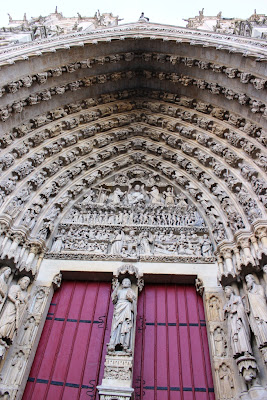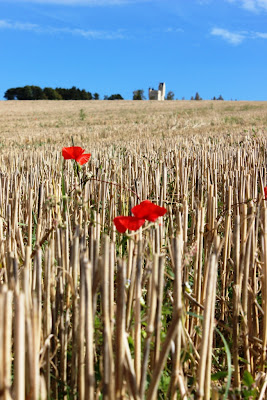Just a week after William returned from his 6 day school trip to Normandy in mid September, he was heading back to France with us to visit the Somme WW1 battlefields, graves and memorials. We were again lucky with the weather, with clear skies for the entire trip. For Australians and New Zealanders the significance of the Somme stems from the role both countries played in WW1. Every year schools in Australia commemorate ANZAC Day with memorials and lessons. Mark has read and taught a lot about the battlefields of Belgium and France. Names such as The Somme, Pozziers, Fromelles & Villers-Bretonneux are almost household words for many people in Australia and New Zealand.
Thanks to an Australian public holiday we took a three day weekend and, for a change, did not race straight off after school. Aisha had been away at a three day school camp and was not due back until late Friday afternoon and Sally was, as ever, busy at work. We decided to drive down on the Friday night to Folkstone, stay the night there and catch an early train across the Channel.
Taking the advice of Jane and Nigel who had visited the week before, we stopped at the Blockhaus at Éperlecques, just an hour's drive from Calais and on the way to the town of Arras, where we were to spend our first night.
The Blockhaus was, & still is, a massive concrete bunker originally built by up to 2,000 slave workers during the latter years of WWII. It was intended to be a launch site for as many as 36 V2 ballistic missiles per day. Fortunately, it was never brought online and no V2 rockets were ever launched from here. Despite that, beginning in September 1944, over 3000 V2s were launched against Allied targets during the war, mostly London and later Antwerp and Liege in Belgium - a fact we did not know. The attacks resulted in the death of an estimated 7250 military personnel and civilians.
It doesn't bear thinking about if The Blockhaus had ever become operational !
Unlike the V1 (also known as 'doodle bugs' or 'buzzbombs'), the V2 was a supersonic rocket. Flying at Mach 4, twice the speed of Concorde, and reaching an altitude of 110km (it was the first man made object to enter space) meant it was almost impossible to defend against. Both Mark & Sally's parents talk about the noise of the doodle bugs but that the V2s just appeared with almost no warning. A plan was apparently proposed where the V2 would be detected by radar and its likely impact point calculated. The area along that trajectory of the rocket was then to be saturated by large-calibre anti-aircraft guns. The plan was never implemented though after it was reckoned that the likely damage and casualties resulting from malfunctioning artillery shells would be greater than that caused by the V2.
 |
| The Blockhaus. |

 |
| Despite many, many attacks little damage was done by the 1 tonne bombs. |
 |
| A real V-2 rocket in the Imperial War Museum, London. |
 |
| Although not launched from here, there were displays on 'doodle bugs' |
For many people the words 'The Somme' conjures up grainy images of trench warfare and represents the futility of war. The facts of the various battles in the Somme region are appalling, well documented and fairly well known. At a time when the deaths of individual soldiers makes international news, it is incomprehensible how so many deaths could be hushed up as they were, let alone accepted. In the battles around Fromelles, a combined operation between British troops and the Australian Imperial Forces (AIF), 1,500 British and 5,533 Australian soldiers were killed, wounded or taken prisoner after just 24 hours. It was the first occasion that the AIF saw action on the Western Front. Described as "the worst 24 hours in Australia's entire history". The Australian and British losses were sustained without gaining any ground at all.
As with many of the towns in the Somme, there were many references to Australia.
 |
| In the Armiens Cathedral. |


 |
| Friends School. |
We were also on a mission to visit the grave of Sally's grandpa's first cousin, Ronald McKenzie, at Philosophe British cemetery at Mazingarbe. Ronald died on 10 November 1918, 3 days before the end of WWI.
Sal's mum Margaret had researched his whereabouts when she rescued documents her father was planning to burn after he had finalised Ronald's younger sister's will. These included some photos of the grave as it originally was with a wooden cross, a photo of Ronald's mother coming to see where her son was buried after the war, and a poignant letter written to his parents by a young woman in the nearby village, explaining the care being given to the grave and offering to show them where it was if they came to visit. With this information and more obtained from the British War Graves Commission, Margaret located Ronald's grave and visited it herself a couple of years ago. It was moving for us to have this tangible connection, to find the grave, read through the information we had and leave a flag, gum leaves and a message from the Aussie connection.


As part of the trip down to Arras we stopped at the shell battered church of Ablain-Saint-Nazaire. The Gothic designed church was built in the 16th century. It was all but destroyed during WWI but was deliberately left un-restored to symbolise the horrors of war.

We went to the VC Corner cemetery which is the only uniquely Australian cemetery in France. It was formed after the armistice and contains the graves of 410 Australian soldiers whose bodies were found on the battle field after the July 1916 attacks. As none of the bodies could be identified it was decided to leave the graves without headstones.
 |
| VC Corner. |
A trip like this was bound to be sombre and inevitably the impact of so many graves was initially high but became less so as the weekend wore on. Some that made a lasting impression were;
This headstone was especially poignant. This was the only one we saw that spoke of the reality of war. At a time when inscriptions spoke of duty, courage, eternal rest, King and country and so on, we were impressed at the bravery of private Rae's next of kin in voicing such sentiments.
This headstone was especially poignant. This was the only one we saw that spoke of the reality of war. At a time when inscriptions spoke of duty, courage, eternal rest, King and country and so on, we were impressed at the bravery of private Rae's next of kin in voicing such sentiments.
We saw quite a few headstones for brothers killed often on the same day.


 |
| The Wilson brothers. |
While the battle fields of The Somme have been quiet for over 90 years, they still impact on the local inhabitants. It is well know that farmers still plough up relics. This grave marks the remains of a soldier which were only found in 1998. Hundreds of German soldiers died when massive underground mines were detonated. His body was found just a few metres from the main path where thousands of tourists have walked over the years.
 |
| The 'Grand Mine' crater. |

We have been many times to the Australian War memorial in Canberra. As with Westminster Abbey here in London, a main feature of the memorial is the grave of the unknown soldier. Plans for a tomb for an Australian unknown soldier were first put forward in the 1920s but it was not until 1993 that someone was at last brought home. We knew that the remains of an unknown Australian were removed from a cemetery in France in 1993. On this trip we were able to see the grave he came from. He was buried in a Tasmanian blackwood coffin, with a slouch hat and a sprig of wattle. Soil from the Pozières battlefield was scattered on his tomb.

 |
| At the Australian War Memorial in Canberra. |

Villers-Bretonneux is a name well known to anyone who has read anything of the history of Australians in WWI. Mark has taught ANZAC Day to many different groups of year six and seven kids and has read to them about the defence of the village by Australian forces as well as about the gratitude the locals felt and express with a sign and museum at the local school.
While at the small museum attached to the school, we joined an Australian family we had seen at several battle sites and cemeteries that day when we overheard them talking to the museum staff about a letter on display. It turns out the letter was about their great uncle from Adelaide they were in France to research. They became more aware of his service in the last decade. Previously all they had been told was that he went to war and was killed. They were aware of a letter from the soldier's commander attesting to the man's courage and good character, but had no idea that it was on public display in the museum! No-one knew how or when the letter was donated to the museum. Through this letter, and other information the museum held, they were able to find out more about the war their relative experienced.
 |
| The letter. |
As well as passing countless small cemeteries we passed several somewhat large mounds of recently harvested potatoes. We decided to add a carrot, as you do.

Not all of the trip was sombre wanderings amongst the dead. The towns of Arras and Armiens were fantastic and we managed to squeeze in the odd cathedral or two - much to William's delight. We also climbed the UNESCO listed town hall tower, saw an amazing display of royal sleds and carriages from the Palace of Versailles at the local museum and did a really interesting tour of the Wellington tunnels dug by New Zealand forces to enable a "big push" up to the German front line.
 |
| Armiens Cathedral. |

 |
| The head of John the Baptist in Armiens Cathedral. |
 |
| Armiens back streets. |
Arras was also lovely. We stayed in a hotel right on the main square.


As with many towns in northern France, Arras has giants. Named Colas and Jacqueline & born in the late 1800s, they are part of a tradition which parades them through the streets every August. They commemorate the end of the Spanish occupation in the 1700s. The original giants, at 6.5 metres, were much taller than these ones but were destroyed in WWI. The giants were 're-born' after the war but were again destroyed in 1940. Their latest incarnation, at 4 metres, also includes a child, their son.
We also took advantage of the opportunity to sample more French food. We had mixed feelings about the mains - Will wasn't overly impressed with the oyster Mark forced upon him and in fact Mark himself decided that the oysters we get from Pete our local fish man in East Finchley are better than the ones we had in Armiens. Will did like the venison and duck he had and we all enjoyed the desserts!
After our return, Sally finished reading Birdsong by Sebastian Faulkes - a superbly written and therefore frighteningly evocative novel set in WWI Somme, referencing most of the places we had been. A very powerful book for anyone interested.


















No comments:
Post a Comment